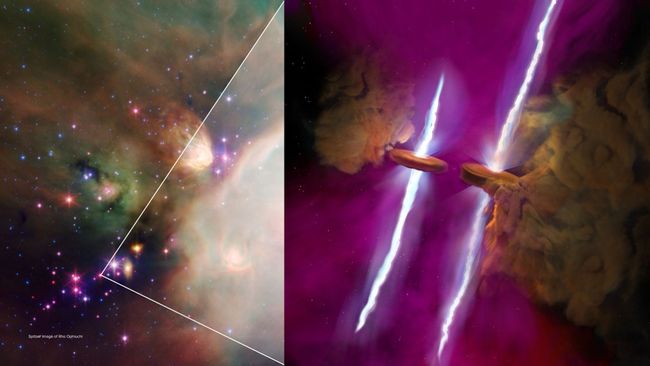Powerful instruments of the telescope helped to look into the cradle of the formation of stars and planets
Shrouded in a dense cloud of gas and dust, a young star in the constellation Ophiuchus, which astronomers have been studying for decades, turns out to be a pair of stars.
The twin stars, located about 400 light-years from Earth in the WL 20 group, are less than a million years old and appear to have pushed away the clouds within which they formed, suggesting processes their births are nearing completion. This means that astronomers can observe stars in the process of transitioning to a more mature stage of their life cycle.
For decades, telescope observations have shown that the group WL 20, which lies inside a massive molecular cloud called Rho Ophiuchi, contains three stars. Although they were born in the same pocket of gas and dust, two stars are about two million years old, and the third star — the dimmest among the group, located at the southern tip of the triangle — turned out to be younger than a million years.
Mary Barsoni, the independent astronomer who led the study, spoke about this on June 12, presenting it at the 244th meeting of the American Astronomical Society in Wisconsin. Many astronomers, including Barsoni, have spent decades studying the stars in WL 20 and their environment around Rho Ophiuchi. «We thought we knew this area pretty well», — she said in a statement to NASA.
However, when the «James Webb» observed the region, its Mid-Infrared Camera (MIRI) discovered that the third star, named WL 20S, is actually a pair of twins itself — each has coincident jets emitted from the north and south poles. Additional observations with the Atacama Large Millimeter/submillimeter Array (ALMA), a large network of 60 radio antennas in Chile that operate as a single giant telescope, revealed that each of the twin stars is also surrounded by a disk of gas and dust. If one of the twin stars replaced our Sun, its disk would extend beyond Saturn's orbit, Barsoni said.
«We were stunned when we first saw the results of the observations»,— she told reporters during a press briefing. Without MIRI, astronomers would not have known about the twin star or the jets, she added.
Astronomers do not fully understand how multiple star systems, such as the four-star system in WL 20, form. Thus, future observations of «quadruples» may shed more light on the underlying processes.
«It’s amazing that this region can still tell us a lot about the life cycle of stars», — said study co-author Mike Ressler, a MIRI research scientist at NASA's Jet Propulsion Laboratory who has been studying the WL 20 cluster for nearly 30 years.

